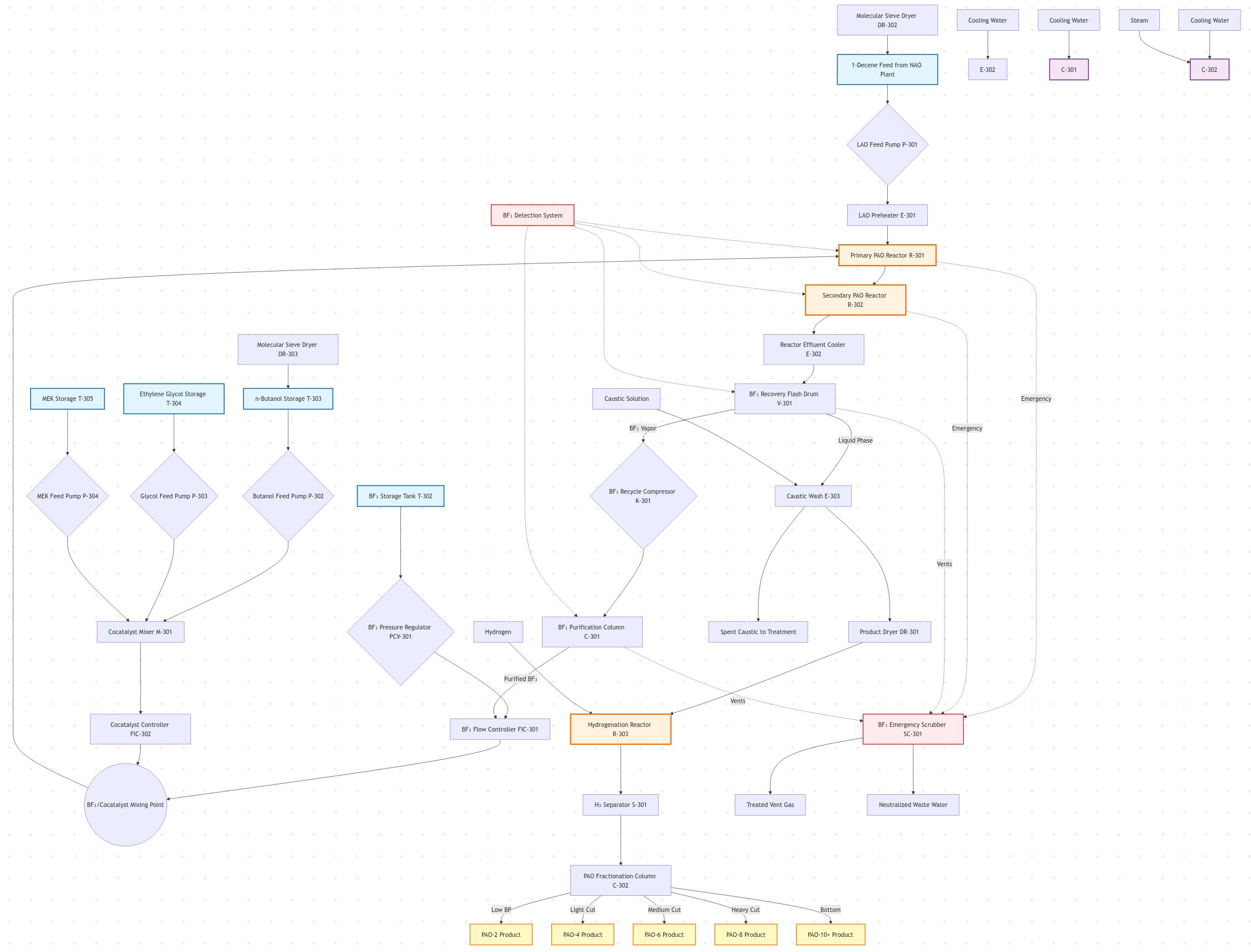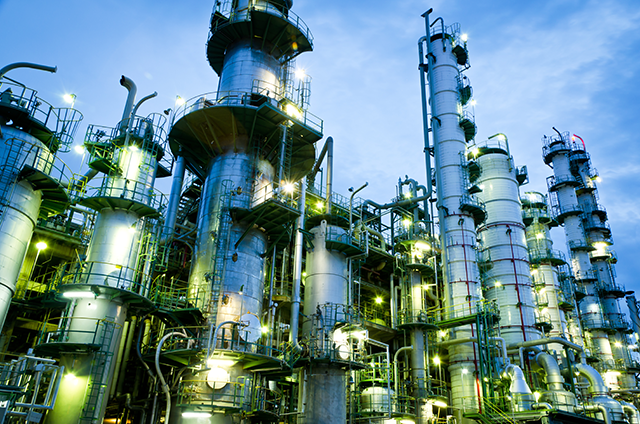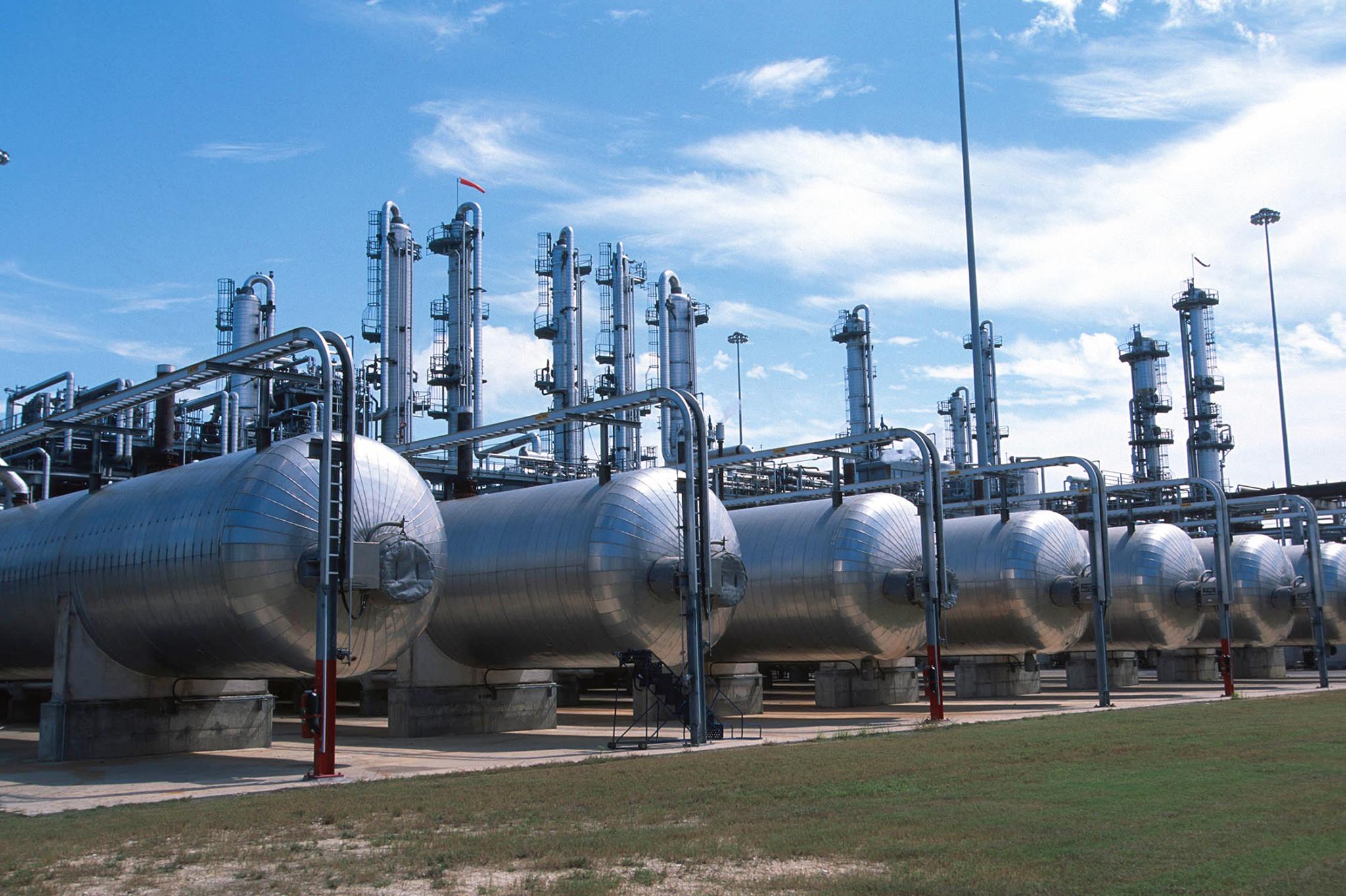Process Overview
Chevron Phillips Chemical (CPChem) operates a commercial boron trifluoride (BF₃) catalyzed oligomerization process that converts linear alpha olefins (LAOs) into polyalphaolefins (PAOs) for synthetic lubricant applications. The technology is based on Gulf Oil's pioneering cationic oligomerization chemistry, enhanced with a three-component cocatalyst system for optimal product distribution.
Technical Foundation
Catalyst System
- Primary Catalyst: Boron Trifluoride (BF₃) - Function: Lewis acid catalyst for cationic polymerization - Loading: 0.55-0.81 wt% of olefin feed - Partial pressure: 20-100 psig in reactor system - Recovery: >95% through flash separation and purification
- Three-Component Cocatalyst System (Gulf Oil Patent EP0077113A1)
- n-Butanol (75-95 wt% of cocatalyst mixture)
- Primary alcohol for carbocation initiation
- Forms BF₃·alcohol complex as active catalyst
- Ethylene Glycol (2-15 wt% of cocatalyst mixture)
- Chain transfer agent for molecular weight control
- Enhances trimer/tetramer selectivity
- Methyl Ethyl Ketone (2-15 wt% of cocatalyst mixture)
- Selectivity modifier for viscosity grade optimization
- Improves trimer yield for PAO-4 production
- Total Cocatalyst Loading: 0.36-0.80 wt% of olefin feed
Process Chemistry
- Cationic Oligomerization Mechanism:
- Initiation:
BF₃ + ROH → BF₃·ROH (catalyst complex formation)
BF₃·ROH + 1-Decene → Decyl carbocation + BF₃OR⁻
- Propagation:
C₁₀H₂₁⁺ + n(1-Decene) → C₁₀(₁₊ₙ)H₂₁(₁₊₂ₙ)⁺
- Chain Transfer (Enhanced by Glycol/Ketone Components):
Growing chain⁺ + Transfer agent → PAO product + New initiation site
Process Flow Description
Figure 1 - Block Flow Diagram of CPChem's BF3-catalalyzed Process for LAOs oligomerization into PAOs | Perplexity AI generated in Mermaid Code Format, code is provide in the appendix and scalable chart can be viewed here.

Feed Preparation Section
- LAO Storage and Handling - T-301: 1-Decene storage tank with nitrogen blanketing - Molecular sieve drying to <10 ppm water (critical for BF₃ activity) - P-301: Feed pump with flow control to reactor system - E-301: Feed preheater to reaction temperature
Catalyst Preparation Section
- BF₃ Storage and Feed - T-302: High-pressure BF₃ storage vessel (PTFE-lined) - PCV-301: BF₃ pressure regulator (20-100 psig operating range) - FIC-301: BF₃ flow controller with precise metering
- Cocatalyst Blending - T-303: n-Butanol storage with molecular sieve drying - T-304: Ethylene glycol storage tank - T-305: Methyl ethyl ketone storage tank - M-301: Three-component mixing system with composition control - FIC-302: Cocatalyst mixture flow controller
Oligomerization Reactor System
- Two-Reactor CSTR Configuration - R-301: Primary oligomerization reactor (PTFE-lined) - R-302: Secondary completion reactor (PTFE-lined) - Operating conditions: 45-55°C, 20-100 psig BF₃ partial pressure - Residence time: 1.5-4 hours total (batch mode data) - Continuous operation with steady catalyst and feed injection - E-302: Reactor effluent cooling to separate BF₃
BF₃ Recovery System
- Flash Separation - V-301: BF₃ recovery flash drum (<2 psia operation) - Separates BF₃ vapor from liquid PAO product stream - K-301: BF₃ recycle compressor
- BF₃ Purification - C-301: BF₃ recovery column (PTFE-lined internals) - Removes alcohol and water impurities from recycled BF₃ - Achieves >95% BF₃ recovery efficiency
Product Processing Section
- Neutralization and Washing - E-303: Caustic wash system for BF₃ neutralization - Counter-current washing with dilute NaOH solution - DR-301: Product dryer (molecular sieve or vacuum distillation)
- Hydrogenation - R-303: Hydrogenation reactor (Ni or Pd catalyst) - Operating conditions: 150-200°C, 50-200 psig H₂ - Purpose: Saturate residual double bonds for thermal stability - S-301: Product separator for hydrogen recovery
PAO Fractionation Section
- Product Separation by Viscosity - C-302: Multi-cut distillation column - Separation based on molecular weight/viscosity - Product cuts: PAO-2 (dimer-rich), PAO-4 (trimer-rich), PAO-6 (tetramer-rich), higher viscosity grades
Safety Systems
- BF₃ Emergency Response - SC-301: Emergency caustic scrubber system - All BF₃-containing equipment vented to scrubber - Gas detection system throughout BF₃ handling areas - Emergency shutdown systems with automatic isolation
Process Performance
Product Distribution Enhancement
- Traditional BF₃/Alcohol System: - Trimer/Tetramer ratio: 1.3-1.7:1 - Limited control over molecular weight distribution
- CPChem Three-Component System: - Trimer/Tetramer ratio: 2.2-3.3:1 (66% improvement) - Enhanced selectivity for PAO-4 viscosity grade
Product Quality (Gulf Oil Patent Data)
- PAO-4 Grade (4 cSt @ 100°C):
- Composition: 79.3% trimer (C₃₀), 20.2% tetramer (C₄₀)
- Viscosity index: 125
- Low temperature viscosity (-40°F): 2,465 cSt
- PAO-6 Grade (6 cSt @ 100°C):
- Composition: 26.6% trimer, 52.0% tetramer, 21.4% pentamer
- Viscosity index: 138
- Low temperature viscosity (-40°F): 7,269 cSt
Technology Validation
Patent Evidence
- US Patent 6410812B1 (2002): CPChem BF₃ recovery process
- EP Patent 0077113A1 (1982): Gulf Oil three-component cocatalyst
- Both patents specifically for alpha olefin oligomerization to PAO
Commercial Confirmation
- Gulbrandsen supplier relationship (2025): Active BF₃ supply to CPChem
- Capacity expansions: Beringen doubling (2022-2025) confirms technology success
- 60+ years operation: Continuous commercial operation since Gulf Oil era
Commercial Implementation
Cedar Bayou, Texas
- Capacity: 58,000 MT/year PAO (10,000 MT/yera expansion from 48,000 MT/year completed in 2017)
- Integration: Direct 1-decene supply from on-site NAO plant
- Product Range: Full spectrum PAO-2 through PAO-100
- Feedstock Advantage: Captive supply eliminates market exposure
Beringen, Belgium
- Capacity: 120,000 MT/year (doubled in 2025)
- Focus: Low-viscosity PAO for European automotive market
- Products: Primarily PAO-2, PAO-4, PAO-6 grades
Process Advantages
Technical Benefits
- High BF₃ Recovery: >95% catalyst recycle reduces operating costs
- Enhanced Selectivity: Three-component system optimizes trimer/tetramer ratio
- Product Quality: Superior viscosity index and low-temperature properties
- Process Flexibility: Single platform produces multiple PAO grades
- Integration Synergy: Direct LAO feedstock from captive production
Economic Benefits
- Feedstock Security: Integrated 1-decene supply reduces cost volatility
- Catalyst Efficiency: High recovery minimizes fresh BF₃ consumption
- Product Premium: High-quality PAO commands lubricant market premiums
- Scale Advantages: Large-scale operation reduces unit costs
Environmental and Safety Considerations
BF₃ Handling Requirements
- Personnel Protection: Full respiratory protection in BF₃ areas
- Material Compatibility: PTFE-lined equipment for BF₃ service
- Emergency Procedures: Caustic neutralization systems
- Waste Minimization: High catalyst recovery reduces disposal
Environmental Performance
- Catalyst Recovery: >95% BF₃ recycle minimizes emissions
- Energy Integration: Heat recovery from exothermic oligomerization
- Waste Streams: Minimal liquid waste through efficient separation
- Product Stability: Hydrogenated PAO eliminates oxidation concerns
Market Position and Applications
PAO Market Segments
- Automotive: Engine oils, transmission fluids (PAO-4, PAO-6)
- Industrial: Hydraulic fluids, gear oils (PAO-8, PAO-10)
- Specialty: High-temperature applications (PAO-40, PAO-100)
- Compressor Oils: Low-viscosity applications (PAO-2)
Competitive Advantages
- Technology Leadership: Pioneer in BF₃-catalyzed PAO production
- Vertical Integration: Captive LAO feedstock supply
- Global Scale: Multiple production sites serve regional markets
- Product Range: Complete viscosity spectrum from single technology
References
- European Patent EP0077113A1 (1982). "Olefin oligomerization using boron trifluoride and a three-component cocatalyst." Gulf Research & Development Company.
- US Patent 6410812B1 (2002). "Process for recovering boron trifluoride from a catalyst complex." Chevron Phillips Chemical Company LP.
- Gulbrandsen Technologies Press Release (2025). Gulbrandsen recognized by Chevron Phillips Chemical Company as a trusted supplier of boron trifluoride (BF₃).
- CPChem News Release (2014). Chevron Phillips Chemical Announces PAO Expansion Study at Cedar Bayou Plant.
- CPChem News Release (2017). Chevron Phillips Chemical Announces Expansion of PAO Capacity at its Cedar Bayou Plant.
- CPChem News Release (2012). Chevron Phillips Chemical breaks ground on polyalphaolefin expansion in Beringen, Belgium.
- CPChem News Release (2025). Chevron Phillips Chemical completes low viscosity PAO expansion in Belgium.
Open the diagram here!
flowchart TD
%% Feed Systems
A[1-Decene Feed from NAO Plant] --> B{LAO Feed Pump P-301}
C[BF₃ Storage Tank T-302] --> D{BF₃ Pressure Regulator PCV-301}
E[n-Butanol Storage T-303] --> F{Butanol Feed Pump P-302}
G[Ethylene Glycol Storage T-304] --> H{Glycol Feed Pump P-303}
I[MEK Storage T-305] --> J{MEK Feed Pump P-304}
%% Feed Preparation
B --> K[LAO Preheater E-301]
D --> L[BF₃ Flow Controller FIC-301]
F --> M[Cocatalyst Mixer M-301]
H --> M
J --> M
M --> N[Cocatalyst Controller FIC-302]
%% Catalyst Preparation
L --> O((BF₃/Cocatalyst Mixing Point))
N --> O
%% Reaction Section
K --> P[Primary PAO Reactor R-301]
O --> P
P --> Q[Secondary PAO Reactor R-302]
Q --> R[Reactor Effluent Cooler E-302]
%% BF₃ Recovery
R --> S[BF₃ Recovery Flash Drum V-301]
S -->|BF₃ Vapor| T{BF₃ Recycle Compressor K-301}
T --> U[BF₃ Purification Column C-301]
U -->|Purified BF₃| L
%% Product Processing
S -->|Liquid Phase| V[Caustic Wash E-303]
V --> W[Product Dryer DR-301]
W --> X[Hydrogenation Reactor R-303]
X --> Y[H₂ Separator S-301]
%% PAO Fractionation
Y --> Z[PAO Fractionation Column C-302]
Z -->|Low BP| AA[PAO-2 Product]
Z -->|Light Cut| BB[PAO-4 Product]
Z -->|Medium Cut| CC[PAO-6 Product]
Z -->|Heavy Cut| DD[PAO-8 Product]
Z -->|Bottom| EE[PAO-10+ Product]
%% Safety Systems
P -.->|Emergency| FF[BF₃ Emergency Scrubber SC-301]
Q -.->|Emergency| FF
S -.->|Vents| FF
U -.->|Vents| FF
FF --> GG[Treated Vent Gas]
%% Detection System
HH[BF₃ Detection System] -.-> P
HH -.-> Q
HH -.-> S
HH -.-> U
%% Utilities
II[Cooling Water] --> E-302
JJ[Cooling Water] --> C-301
KK[Cooling Water] --> C-302
LL[Steam] --> C-302
MM[Hydrogen] --> X
NN[Caustic Solution] --> V
%% Molecular Sieve System
OO[Molecular Sieve Dryer DR-302] --> A
PP[Molecular Sieve Dryer DR-303] --> E
%% Waste Streams
FF --> QQ[Neutralized Waste Water]
V --> RR[Spent Caustic to Treatment]
%% Style Classes
classDef feedTank fill:#e1f5fe,stroke:#01579b,stroke-width:2px
classDef reactor fill:#fff3e0,stroke:#ef6c00,stroke-width:3px
classDef column fill:#f3e5f5,stroke:#6a1b9a,stroke-width:2px
classDef compressor fill:#e8f5e8,stroke:#2e7d32,stroke-width:2px
classDef product fill:#fff9c4,stroke:#f57f17,stroke-width:2px
classDef safety fill:#ffebee,stroke:#c62828,stroke-width:2px
class A,C,E,G,I feedTank
class P,Q,X reactor
class C-301,C-302 column
class K-301 compressor
class AA,BB,CC,DD,EE product
class FF,HH safety















